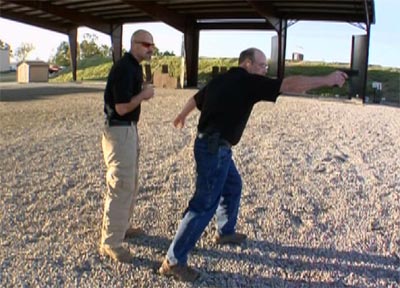Balance of Speed and Precision
By Rob Pincus
All shooting is a balance between speed and precision.
Sometimes you need to be more precise, sometimes you need to be faster. Using this concept, most defensive shooting can be described in the following way: You need to get the hit that you need to get as quickly as you can get it. This statement can be summed up in one word: Efficiency. Efficiency includes effectiveness.
In the Combat Focus ™ shooting program, we explain it this way:
• The target dictates the hit you need to get.
• Your application of skill determines whether or not you get the hit you need to get.
• It is your confidence, or belief, in your ability that determines when you shoot.
The target determines the need for precision. The size of the target and the conditions under which it presents itself (movement, by standers, distance, etc.) are what determines your need for precision. You can always make the shot harder-trying to hit a button on a shirt, for example, rather than accepting any hit in the high center chest-but that works against the goal of maximum efficiency. The target and its circumstances are what determine the true need for precision.
 It is your application of skill, with your given weapon under those given circumstances that will ultimately determine whether or not you actually get the hit you need to get. The concept should be pretty straight forward, particularly if you understand that we are not just talking about your shooting ability, but also about your ability to judge what is going on around you. Specifically, you may possess the skill to mechanically make the shot you need to make, but the ability to apply that level of skill at the time you need it is vital, which is why we stress training realistically.
It is your application of skill, with your given weapon under those given circumstances that will ultimately determine whether or not you actually get the hit you need to get. The concept should be pretty straight forward, particularly if you understand that we are not just talking about your shooting ability, but also about your ability to judge what is going on around you. Specifically, you may possess the skill to mechanically make the shot you need to make, but the ability to apply that level of skill at the time you need it is vital, which is why we stress training realistically.
Your confidence or comfort if you will, in taking the shot at all determines when the shot is taken. Would you pull the trigger on a gun during a critical incident if you didn’t believe that you were going to be able to affect your target’s ability to hurt you or someone else? The easy and right answer is “no”. Of course there is a big exception to this rule. If you are shooting out of fear, you may be pulling the trigger as fast as you can and hoping for the best. In fact, we know this has happened many times during actual critical incidents.
You may be thinking, “So what? Isn’t this article going to tell me when I should use my sights?” No, I’m afraid it isn’t. The question “At what distance should I use my sights?” is right up there with “What gun should I carry?” as one of the least answerable questions ever asked by a student. These are questions that you have to answer. Certainly an instructor can help guide you, as this article is trying to do, but ultimately, you’re the individual ability and confidence are going to determine when you should use your sights to achieve the level of precision that you need for any given shot. I’m sure that you can imagine scenarios where you would definitely chose to use your sights to achieve a hit and those where you would not need them-only through realistic training can you test those theories.
Through realistic practical training, you will learn more about your ability under the circumstances that you are likely to find during a dynamic critical incident. Furthermore, the more realistic your training, the more likely it is to help you recognize the circumstances of a dynamic critical incident and respond more efficiently. Lastly, this type of training can also help you work with the body’s natural reactions to fear and shock and allow you to overcome the possibility of simply shooting out of fear.
The better you understand your personal balance between speed and precision, the more accurate the correlation between your belief in your ability in a dynamic critical incident and your actual ability will be, and the more efficiently you’ll be able to deal with a lethal threat.
![]()
* BACK TO EPISODE 4 * DISCUSS THIS TOPIC ON THE FORUM *





